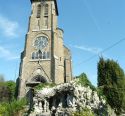The Vesdre region in the 19th century - car
Discover to what extent the wool industry has allowed the development of the villages around Verviers. This "suburb" is made up of towns and villages that were hit hard by the industrial revolution. Changed forever, they also have a heritage that is worth a look...
This car tour is part of three itineraries designed by the network Open Churches, The Verviers Region at the time of the Industrial Revolution (FR).
Continue on PC Download PDF Continue on mobile
-
Saint-Fiacre Church – Dison
In a "neo-medieval" style, the Saint-Fiacre church is a witness to the industrial development of Dison in the 19th century. Its architecture reinterprets the Romanesque and Gothic styles in new proportions, as shown by its high octagonal bell tower with turrets (...)
-
Dison
Before the golden age, Dison was a hamlet whose main resource was agriculture, but which had already been involved in the cloth industry for several centuries (...)
-
Notre-Dame de Lourdes Church – Wegnez
Wegnez has two churches: one in the centre of the original village and this one, in a district born in the 19th century, when the Route de la Vesdre and later the railway were built for industry (...)
-
Saints-Antoine-et-Apolline Church – Pepinster
From the outside, there is no indication of the richness of the church's decorations. Classified as an exceptional heritage of Wallonia, it is considered as "one of the 100 wonders of Wallonia" (...)
-
Pepinster
Like Verviers, Pepinster is an old industrial city. It was born at the confluence of two rivers that are sources of energy: the Vesdre and the Hoëgne. Connected to the railway network in 1843, its station is at the crossroads of two international lines (...)
-
Vieux-Bon-Dieu Sanctuary - Tancrémont
Halfway between the city of Pepinster and the sanctuary of Banneux, this hamlet, known for its large pies, has another treasure: an old cross from the late 9th century!





